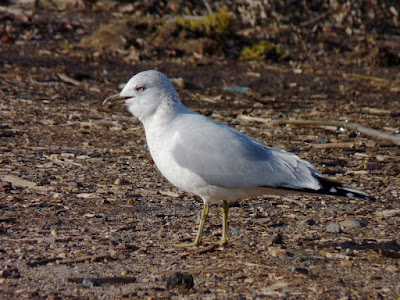 |
| Hooded Crow in Berlin / Photo by pelican |
The Crowbusters' kill rates are unusually high thanks to their military-grade equipment. During a hunt in the Upper Franconia region of Bavaria, the Crowbusters impressed local hunters by bringing down a total of 316 "crap-scratchers." Farmers, who don't like it when curious crows peck at the plastic covers on silage bales, had spread liquid manure on their fields to lure the birds.The excuse for this slaughter is that crows are causing the declines of rabbits, gamebirds, and songbirds – declines that are more likely caused by the spread of agricultural practices that reduce the hedgerows and meadows that provide habitat for those birds and animals. In other words, killing large numbers of crows is unlikely to helps those birds and animals and may hurt some protected species that have the misfortune of associating with large crow flocks. The good news is that the excessive crow-killing has aroused some opposition, even among hunting organizations, but it remains to be seen whether this opposition will be able to rein in the Crowbusters.
The headline "80 Against Unlucky Raven" appeared in a Wild und Hund story describing the biggest crow hunt the publication had ever organized. The shootout in the sky took place last year in the Münsterland region of northwestern Germany, and it was broadcast live on the online forum of Wild und Hund.
By the end of the hunt, 333 crows lay dead, 80 percent of which were young birds. Six magpies also fell victim to the slaughter. In a hunt like this, says ornithologist Ulrich Mäck, it's almost impossible to avoid killing protected species, such as rooks and jackdaws. "Especially during the colder half of the year," he adds, "birds in the crow family tend to fly in mixed flocks."
"I've never experienced such feverish hunting of a particular species, not even when it comes to foxes," says Johann Beuke, a 56-year-old resident of Twistringen, a town in Lower Saxony, and a member of Germany's ÖJV ecological hunting association. According to Beuke, crow populations are particularly threatened by the fact that many German states have bowed to hunter pressure by virtually eliminating hunting off-seasons. In doing so, they are contravening not only an EU directive on the conservation of wild birds, but also Germany's Animal Protection Act. In an attempt to put a stop to what Beuke calls "extermination campaigns," the ÖJV has teamed up with Friends of the Earth Germany (BUND) and the Nature and Biodiversity Conservation Union (NABU).Hopefully this senseless practice will end soon.
These large-scale killing sprees are even too much for some conservative hunters. Harry Neumann, a local BUND representative, convinced Klaus Skowronek, the head of a hunting club in the western German Westerwald mountains, to no longer allow the Crowbusters to hunt in the region. "As far as we're concerned, this area is now a no-go," Skowroneky says, adding that he finds "crow pingpong distressing."
Even the conservative German Hunting Association (DJV) has recently decided that the "excesses" and "questionable images" associated with the Crowbusters' actions could hurt the image of hunting in general. In late February, the association plans to address the problem of these marauding crow killers.
















































